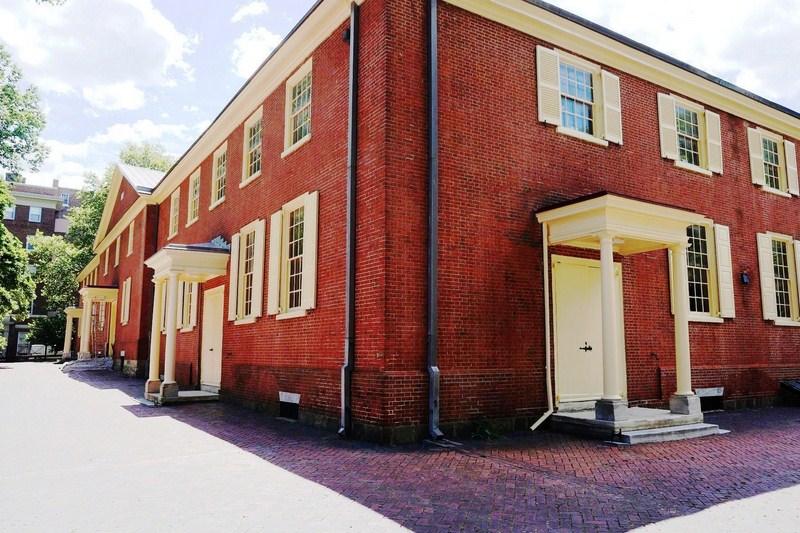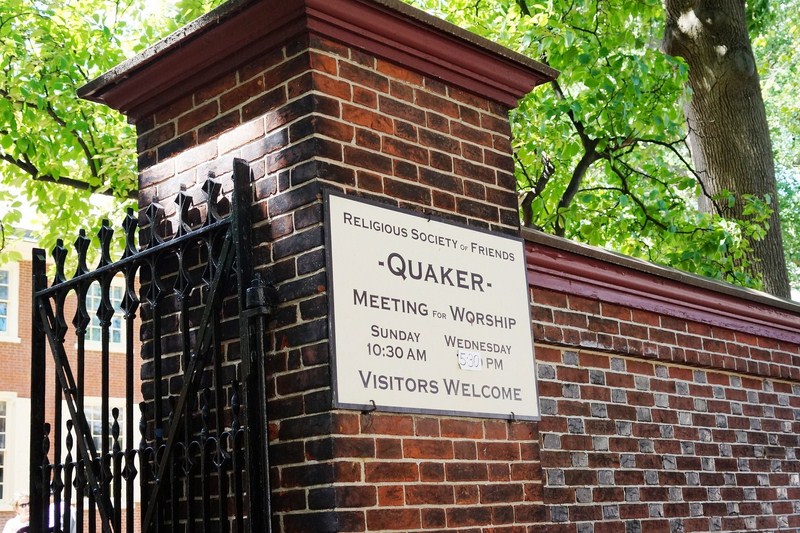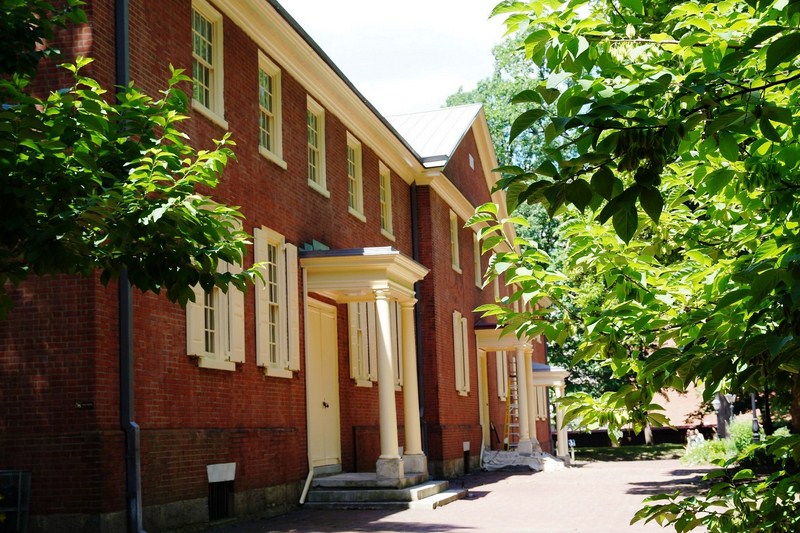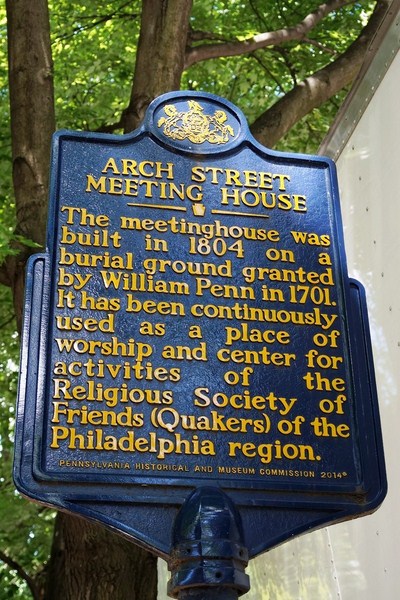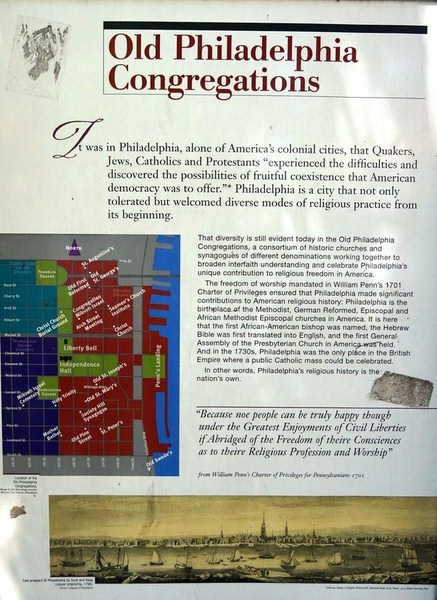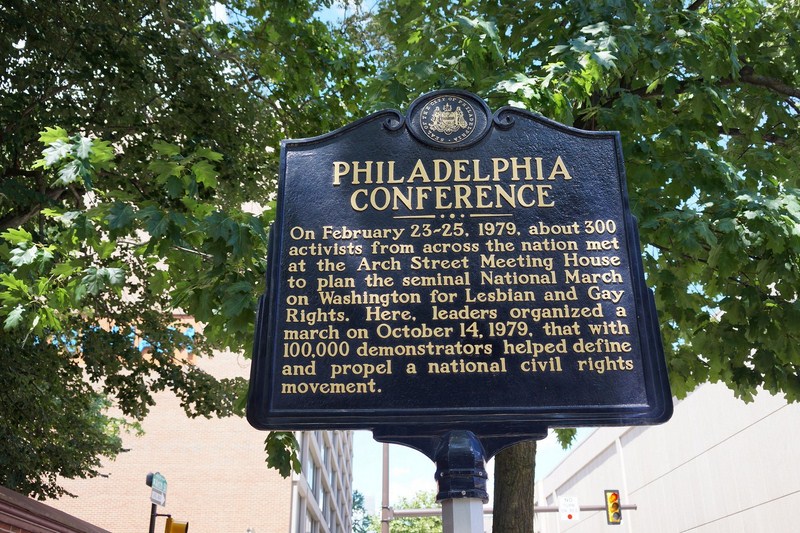The Arch Street Friends Meeting House, within the Old City neighborhood, is a Meeting House of the Religious Society of Friends (Quakers). Built in the Georgian architectural style to reflect the Friends’ testimonies of simplicity and equality, this building has, after more than two centuries of continuous use, changed little. Its grounds was the first burial ground for Quakers in Philadelphia.
The oldest Friends Meeting House still in use in Philadelphia, it is also the largest in the world. Originally designed by the Quaker carpenter Owen Biddle Jr. (best known as the author of a builder’s handbook, The Young Carpenter’s Assistant, published in 1805), architects Walter Ferris Price and Morris & Erskine also contributed to the design and construction of the building.
The two-storey meeting house has two separate entrances at the front of the building, a large first floor meeting space with benches, and an interior second-storey gallery. Since worship involves silent contemplation without clergy or ritual, there is no need for an altar, pulpit, steeples, stained glass windows and other religious symbols.
Here is the historical timeline of the building:
- In 1701, Pennsylvania founder and Quaker William Penn deeded land to the Society of Friends to be used as a burial ground.
- Between 1803 and 1805, the east wing and center of the meeting house was built according to a design by the Quaker carpenter Owen Biddle Jr.
- From 1810–11, the building was enlarged with the addition of the west wing.
- In 1896, an external restroom facility with toilets was added behind the West Room.
- In 1902 and 1908, a kitchen was constructed
- From 1968–69, the 1896, 1902, 1908 additions were removed and the well-known architecture firm Cope & Lippincott renovated the interior of the east wing and designed the two-storey addition (with a smaller room for meetings and worship and second floor conference rooms) behind the center building.
- In 1971, the meeting house was listed on the National Register of Historic Places.
- In 2011, as a consequence of the building being the only surviving documented work by Owen Biddle, it was declared as a National Historic Landmark and the Arch Street Meeting House Preservation Trust was formed.
Today, the Meeting House continues to be a center for worship and the activities of the Monthly Meeting of Friends of Philadelphia, conducted since the 19th century, and the Philadelphia Yearly Meeting of Friends living in Philadelphia, the southern half of New Jersey, Delaware and parts of Maryland is held here every spring.
Notable members of the Religious Society of Friends who worshiped at this meeting house include Sarah and Angelina Grimke, both abolitionists and woman rights advocates. Noted painter Edward Hicks, the cousin of Elias Hicks, also attended meetings here.
The Meeting House has an entrance hall and three distinct sections. The West Wing, added in 1811 to accommodate the women’s Monthly Meeting, is now the room used for worship. Here, two staircases lead to the balcony. The middle section serves as the site of Monthly Meetings and special events.
The East Wing houses dioramas depicting the main events in the life of illustrious Quaker William Penn – Penn the Peacemaker laying down his sword (1668); Penn the Defender of Liberties in prison (1670); Penn the Builder of Democracy writing his “Frame of Government” (1682); Penn the Friend of the Indians completing a treaty with a tribe (1682); Penn the City Planner with his surveyor Thomas Holme, studying Holme’s map (1683); and Penn the Founder of Schools (1699). Also on display is a dollhouse representing the home of noted Quaker journal-keeper Elizabeth Drinker and her husband Henry. Special shows are also held in the East Wing.
Since as early as 1683 (when Mary Lloyd was buried here), burials had been taking place at the ground upon which the meetinghouse was built. Around 20,000 are buried here including many victims of the yellow fever epidemic of 1793. In 1880, burials here were officially ended. Samuel Carpenter (1649–1714), a Deputy Governor under William Penn and the “First Treasurer” of Pennsylvania, and most of his family and his brother Abraham Carpenter (a non-member who married a Quaker) were buried here. At dawn of November 10, Marines mark the grave of Samuel Nicholas (1744–1790), the founder and first commandant of the United States Marine Corps (curious considering the pacific stance of Friends), with a wreath.
Other notable interments here include:
- Owen Biddle Jr.
- Charles Brockden Brown (1771–1810) – the first American novelist (Wieland)
- Lydia Darrah (1728–1789) – Revolutionary War spy
- James Logan (1674–1751) – secretary to William Penn who, along with Penn and Benjamin Franklin, is one of the three most important men in Philadelphia’s Colonial period. He lies here in an unmarked grave.
- Robert Waln (1765–1836) – U.S. Congressman
- Thomas Wynne (1627–1691) – one of the original settlers of Philadelphia, this Wales-born personal physician of William Penn accompanied Penn on his original journey to America on the ship Welcome.
- Caspar Wistar (1761–1818) – American physician, professor of anatomy and vice president of the American Philosophical Society who mentored Meriwether Lewis before Lewis joined William Clark on the expedition to cross the western part of the continent.
- Thomas Stretch (1697-1765) – American clockmaker
Arch Street Friends Meeting House: 320 Arch Street cor. 4th Street, Philadelphia, Pennsylvania. Our Open Tuesdays – Saturdays, 9 AM – 5 PM (Grounds), Fridays – Saturdays, 10 AM – 4 PM (Building). Admission: US$5 (general) and US$2 (children, seniors, veterans and students). Website: www.historicasmh.org. Coordinates: 39°57′7.2″N 75°8′50.17″W.

